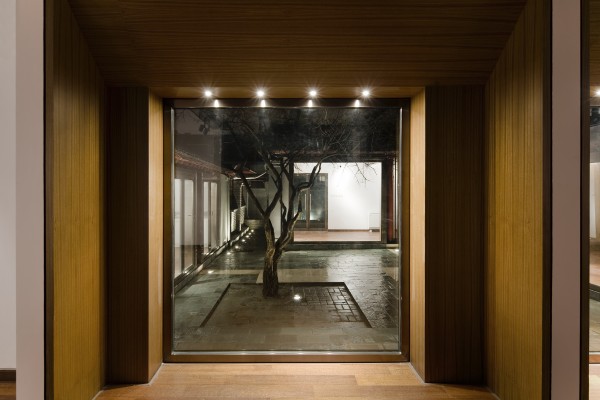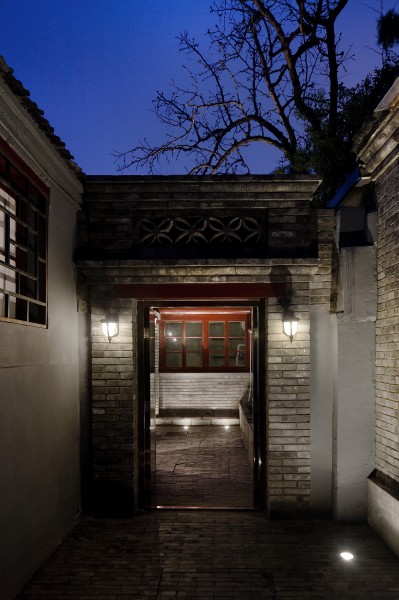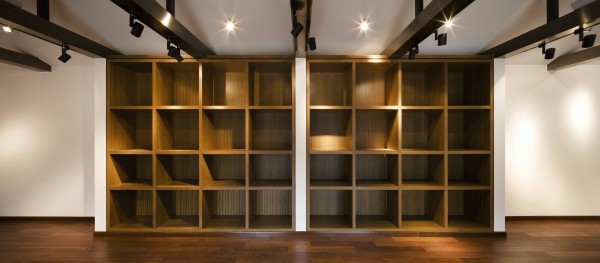In an old capital like Beijing, the most impressive thing should be visiting those mysterious mansions in alleyways. The night lighting in Beijing is more elegant than other Chinese cities as it is calm and noble. The main purpose of lighting design for Beijing is not about to highlight the architecture, but about to integrate light with the architecture and surroundings to let the architecture and its background culture tell their own stories.
Author: Uno Lai
Photographer: Jeremy San
Edit & Translate: belight.com
-

-
You can interact with the central courtyard in a Siheyuan room.
(Editor’s note: “Shu Yuan” was an old-fashioned college and “Guan Shu Yuan” means the Official Academy for “Guan” indicates “official” or “imperial” in Chinese. Comparing to an official academy, it was once popular to go private academy to study in ancient China. “Hu Tong” means alleyways.)
Spirits of the courtyard
In a traditional Siheyuan (editor’s note: Siheyuen is an old residential type that is common in China. “Siheyuan” literally means a mansion that is constructed in a courtyard surrounded by a quadrangle, or four buildings.), both lighting and ventilation are provided by the central courtyard of the mansion. We planned to make the courtyard the focus of this mansion through applying modern lighting to create a space which inherit the old culture, and, at the same time, redefine the space in a modern way. Accordingly, we compile different scenes in the courtyard. We adopted local lights that similar to lanterns instead of general wash light so we can apply layers of different brightness onto walls that are made up by new and old materials together.
There are some rules when it comes to landscape lighting: One is to keep the light lower than your waist, some other one is about to control carefully the light onto plants. We chose halogen lamps that have better CRI to create a comfortable and relaxing space. After we were sure that every single room toward the courtyard can access to night views, we started to consider interior lighting.
-

-
Designers use lanterns and buried lights to create a tranquil atmosphere.
The architect kept the setting simple as the space was mainly used for exhibition. Although there is a new floor layer, the architects didn’t destroy the old roof structure. We applied a few symmetrically arranged wide beam warm color lights in the corners to add gradation onto the roof and create the visual effect of extending upwards.
We discussed with the architects to redesign the lighting system for the display
lighting. We installed metallic components on sides of old beams to recess the track system. This kind of lighting is more flexible than pendant fixture, which is better for displaying, and allows visitors to see the roof and old structures. Additionally, we used ground recessed fixture and steplight to strengthen details of this architecture. At the same time, all those lighting methods can make the space more interesting.
After all these lighting for the architecture done, we took further steps to create different effects for the exhibition area. On one hand, we adopted wide and narrow beam angle low voltage halogen adjustable downlights for window showcases for they are easy to dim and their color temperatures is more precise; they are beneficial to create transparency. On the other hand, we had halogen and metal halide lamps of the track lighting system for the interior exhibition lobby. For one thing, they project light further; for another, we wished to have visitors be able to tell the differences between exhibition room, showcases and the surroundings through incandescent color temperature. Last but not least, we can adjust angles according to collections on display. In addition, there are many pieces of china and their lines are the most beautiful part. Although the adjustable halogen lamps can reveal color and shape of a piece of china, it is not easy for visitors to understand the true beauty under such lighting. We suggested the architects to install luminescent panels on some higher platforms so light would projects from these panels upwards and help reveal the beautiful lines.
-

-
Interior lighting design. It is not difficult to image how it would be after displaying all the collections.
When it comes to the main issue of lighting design, it is not all about lighting effects on architecture and space, but the function of the space and the original features. We hope that the visitors can pay their attention to the display and the atmosphere of the space first, and then later notice what the architects and the designers’ effort made to this background environment.















